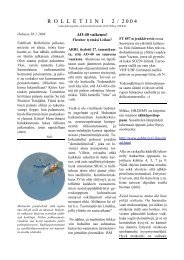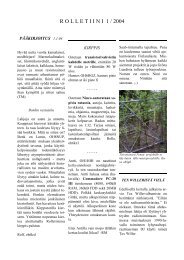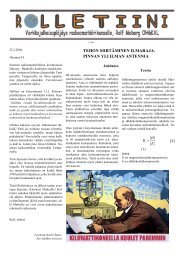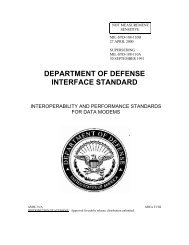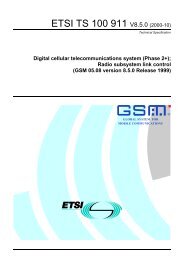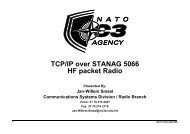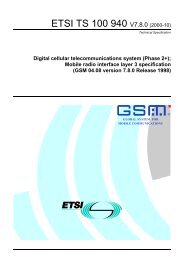nato unclassified - Ham-pages ... No indexes at this level
nato unclassified - Ham-pages ... No indexes at this level
nato unclassified - Ham-pages ... No indexes at this level
Create successful ePaper yourself
Turn your PDF publications into a flip-book with our unique Google optimized e-Paper software.
NATO UNCLASSIFIED<br />
STANAG 5066: PROFILE FOR MARITIME HF DATA COMMUNICATION<br />
V1.0.2<br />
The establishment of a Soft Link D<strong>at</strong>a Exchange Session is initi<strong>at</strong>ed unil<strong>at</strong>erally by the<br />
Subnetwork Interface Sublayer which has queued ARQ U_PDUs and from which a client has<br />
not requested a Hard Link D<strong>at</strong>a Exchange Soft Link D<strong>at</strong>a Exchange Sessions shall be<br />
initi<strong>at</strong>ed as needed, following the procedure described in Section A.3.2.1. When the d<strong>at</strong>a for<br />
<strong>this</strong> node has been transmitted, the session is termin<strong>at</strong>ed immedi<strong>at</strong>ely or after a suitable timeout<br />
period (the time out period would allow for the possibility of new U_PDUs which can be<br />
serviced by the existing soft link session). The procedure for termin<strong>at</strong>ing a Soft Link D<strong>at</strong>a<br />
Exchange Session is described in Section A.3.2.1.2. In order to provide “balanced” servicing<br />
of the queued U_PDUs, a Soft Link D<strong>at</strong>a Exchange Session should not be maintained for a<br />
period which exceeds a specified maximum time if U_PDUs of appropri<strong>at</strong>e priorities are<br />
queued for different node(s). The specific values of the parameters governing the<br />
establishment and termin<strong>at</strong>ion of Soft Link D<strong>at</strong>a Exchange Sessions (e.g. time-out periods<br />
etc.) must be chosen in the context of a particular configur<strong>at</strong>ion (i.e. size of network, etc).<br />
A.1.1.2<br />
Hard Link D<strong>at</strong>a Exchange Session<br />
The second type of d<strong>at</strong>a exchange session is the Hard Link D<strong>at</strong>a Exchange Session. This<br />
session is initi<strong>at</strong>ed <strong>at</strong> the explicit request of a client. A client can request a hard link in order<br />
to ensure th<strong>at</strong> a physical link to a specified node is maintained (irrespective of the<br />
destin<strong>at</strong>ions of other queued U_PDUs) and optionally to partially or fully reserve the capacity<br />
of <strong>this</strong> link. The procedures for establishing and termin<strong>at</strong>ing hard link sessions are described<br />
in Sections A.3.2.2.1 and A.3.2.2.2.<br />
A.1.1.3 Broadcast D<strong>at</strong>a Exchange Session<br />
• The third type of d<strong>at</strong>a exchange session is the Broadcast D<strong>at</strong>a Exchange Session.<br />
During <strong>this</strong> session only non-ARQ U_PDUs can be serviced. A Broadcast D<strong>at</strong>a<br />
Exchange Session can be initi<strong>at</strong>ed and termin<strong>at</strong>ed by a management process, e.g..<br />
a local or network administr<strong>at</strong>or management client. A node configured to be a<br />
broadcast-only node is put in a “permanent” Broadcast D<strong>at</strong>a Exchange Session<br />
during which no hard link requests or ARQ D<strong>at</strong>a U_PDUs can be serviced.<br />
Altern<strong>at</strong>ively the Subnetwork Interface Sublayer can unil<strong>at</strong>erally initi<strong>at</strong>e and<br />
termin<strong>at</strong>e Broadcast D<strong>at</strong>a Exchange Sessions. The rules for initi<strong>at</strong>ing and<br />
termin<strong>at</strong>ing broadcast d<strong>at</strong>a exchange sessions are in Annex C.<br />
A.2 Primitives Exchanged with Clients<br />
Table A-1 lists the primitives exchanged between clients and the Subnetwork Interface<br />
Sublayer. The names of these primitives are prefixed with an “S_” to indic<strong>at</strong>e th<strong>at</strong> they are<br />
exchanged across the interface between the subnetwork interface sublayer and the<br />
subnetwork clients. This table is intended to provide a general guide and overview to the<br />
primitives. For detailed specific<strong>at</strong>ion of the primitives, refer to Figure A-1.<br />
NATO UNCLASSIFIED<br />
2




